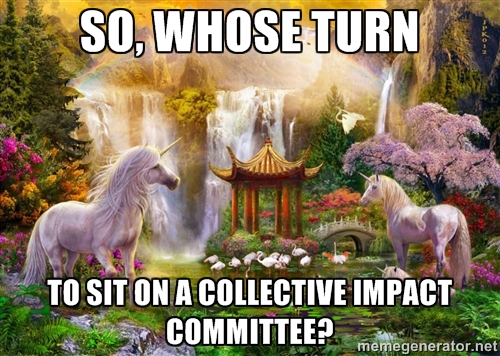
Why we need to end the culture of “Cultural Fit”


 A few weeks ago, a fellow Executive Director of color and a friend of mine, “Maria,” was nearly in tears after failing for a second time to get a small grant. She doesn’t drink, or else I would have offered access to the personal minibar that I keep in my office. A shot of Wild Turkey and a brisk walk always cheer me up after a grant rejection.
A few weeks ago, a fellow Executive Director of color and a friend of mine, “Maria,” was nearly in tears after failing for a second time to get a small grant. She doesn’t drink, or else I would have offered access to the personal minibar that I keep in my office. A shot of Wild Turkey and a brisk walk always cheer me up after a grant rejection.
“I’m so tired,” Maria said over the phone, “I can’t continue putting in my own money to keep this afloat. Maybe nonprofit is just not for me. It’s too hard.” She had spent over 40 hours on these two grants, and I had spent over 12 hours facilitating part of a board retreat, helping develop the logic model, revising the budgets, editing the narratives, and providing moral support.
The grant was a one-time award for less than 10K, and she had been told repeatedly, by different people at this foundation, that her work was important and much needed.
The purpose of this story is not to call out a particular foundation, but to highlight the fact that the standard grant application process needs a deep overhaul because it is leaving behind too many communities. Continue reading “Funders, your grant application process may be perpetuating inequity”
 The question I am asked most frequently—after “Vu, have you tried using Proactiv?”—is “Vu, would you consider joining so-and-so board/committee? If not, can you connect me to other leaders of color who might be interested?” Apparently, everyone is having a hard time finding people of color for their board of directors and 80’s-karaoke-night planning team.
The question I am asked most frequently—after “Vu, have you tried using Proactiv?”—is “Vu, would you consider joining so-and-so board/committee? If not, can you connect me to other leaders of color who might be interested?” Apparently, everyone is having a hard time finding people of color for their board of directors and 80’s-karaoke-night planning team.
There are tons of reports and articles with depressing statistics about diversity in nonprofit leadership at all levels. Here’s an eye-opening article called “The Nonprofit Sector Has a Ferguson Problem,” which cites several stats that make me want to stay in bed streaming Netflix for the rest of the year:
Continue reading “Waiting for unicorns: The supply and demand of diversity and inclusion”
 Go Hawks, everyone. Last week, I wrote about Trickle-Down Community Engagement (TDCE), a frustrating phenomenon that each year causes many of us EDs of grassroot organizations to daydream about abandoning civilization to live with adorable woodland critters, foraging for grubs and berries, which would actually feel very much like nonprofit fundraising, but at least would be cuter and more whimsical. (Note to self: Stop writing blog after watching Disney movies with toddler). Today, I want to touch base on a related topic: Askhole Community Engagement (ACE). TDCE and ACE are connected, like two peas in a dysfunctional pod.
Go Hawks, everyone. Last week, I wrote about Trickle-Down Community Engagement (TDCE), a frustrating phenomenon that each year causes many of us EDs of grassroot organizations to daydream about abandoning civilization to live with adorable woodland critters, foraging for grubs and berries, which would actually feel very much like nonprofit fundraising, but at least would be cuter and more whimsical. (Note to self: Stop writing blog after watching Disney movies with toddler). Today, I want to touch base on a related topic: Askhole Community Engagement (ACE). TDCE and ACE are connected, like two peas in a dysfunctional pod.
So what’s an askhole? Here are some Urban Dictionary definitions. Basically, you know that one friend who keeps coming crying to you about something, asks you for advice, and so you hit pause on Netflix, listen to them attentively, empathize, and give them reasonable suggestions, and then later you find out that they completely ignored you or did the opposite of what you recommended? That’s an askhole. Or someone who keeps asking for advice until they get an answer they agree with. That’s also an askhole.
Continue reading “Are you or your nonprofit or foundation being an askhole?”
 Hi everyone. It’s Thanksgiving this week, and I usually spend a post listing things for which I am thankful—a meaningful job, awesome colleagues, loving family, The Walking Dead, etc.—but something has been weighing on my mind. Equity. It’s like coconut water; everyone’s drinking it lately (See “Is Equity the new coconut water?”). Diversity, inclusion, and cultural competency meanwhile are like hummus: you can’t attend a meeting without at least one clear plastic container of it.
Hi everyone. It’s Thanksgiving this week, and I usually spend a post listing things for which I am thankful—a meaningful job, awesome colleagues, loving family, The Walking Dead, etc.—but something has been weighing on my mind. Equity. It’s like coconut water; everyone’s drinking it lately (See “Is Equity the new coconut water?”). Diversity, inclusion, and cultural competency meanwhile are like hummus: you can’t attend a meeting without at least one clear plastic container of it.
The problem with Equity, Diversity, and Inclusion
Here’s the thing: The people of color that I’ve been talking to are getting kind of sick of these terms. We love them, but the dissonance between their usage and actual practice is like getting poked in the eye on a daily basis. Case in point, at panel I was on recently a colleague of color told me that someone contacted her, saying, “Can you help us spread the word about this new job position? We want to diversify our pool of candidates.”
My friend said, “I wanted to ask, Are you trying to just diversify your POOL of candidate, or ACTUAL hires?” We both sighed; thankfully, the wine was plentiful that evening. Continue reading “The Equity of Risk and Failure”